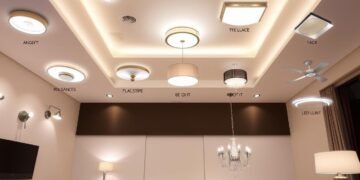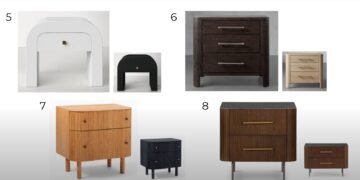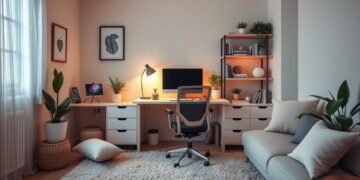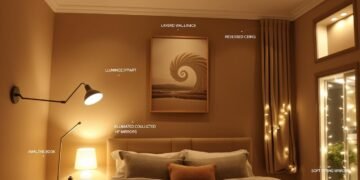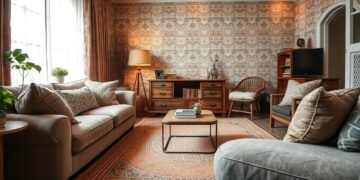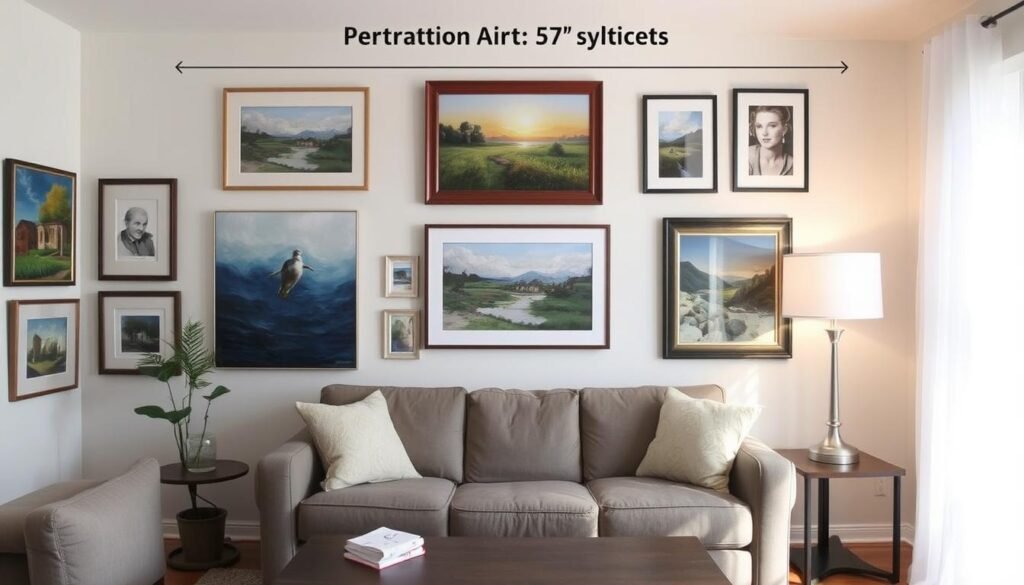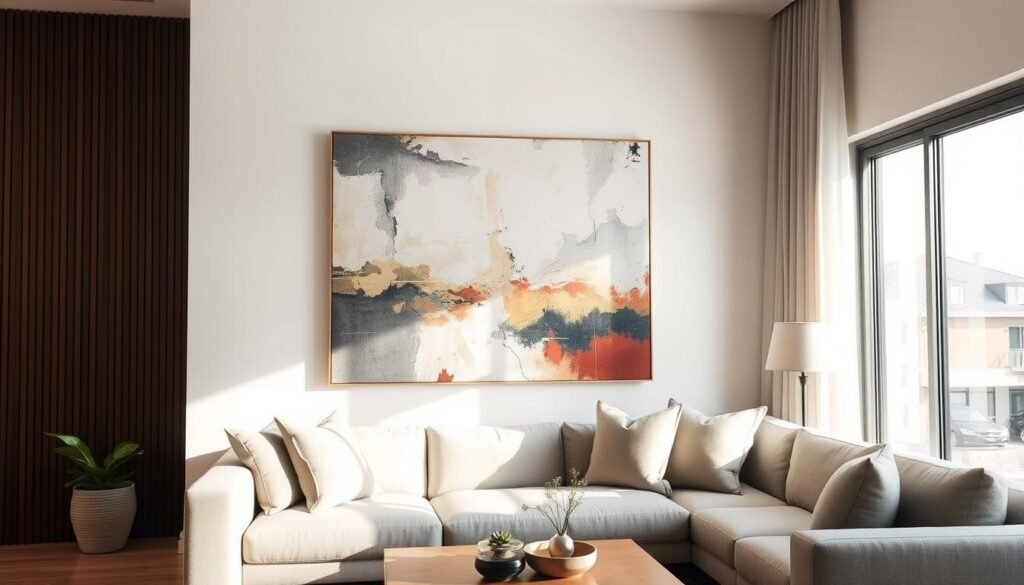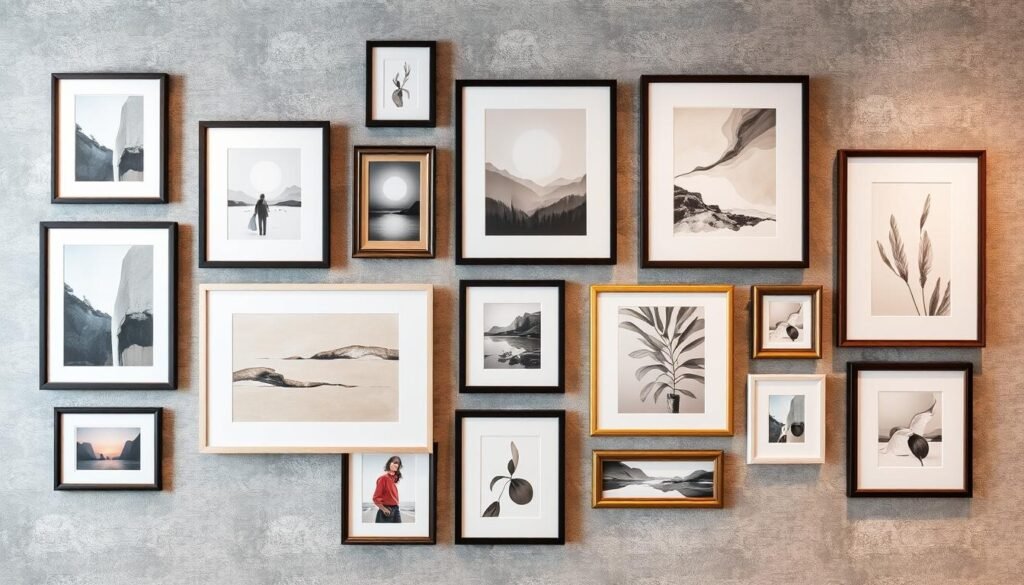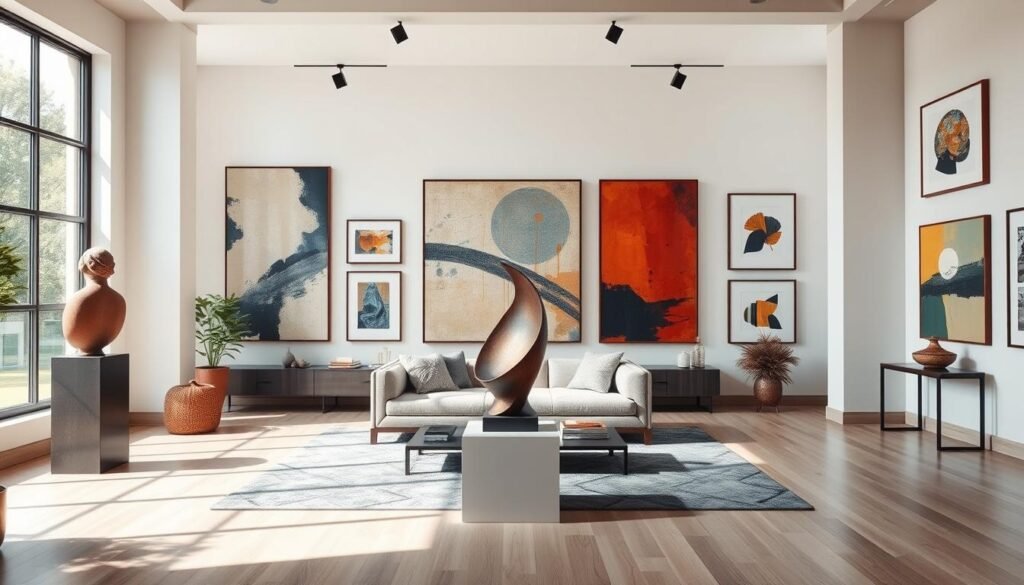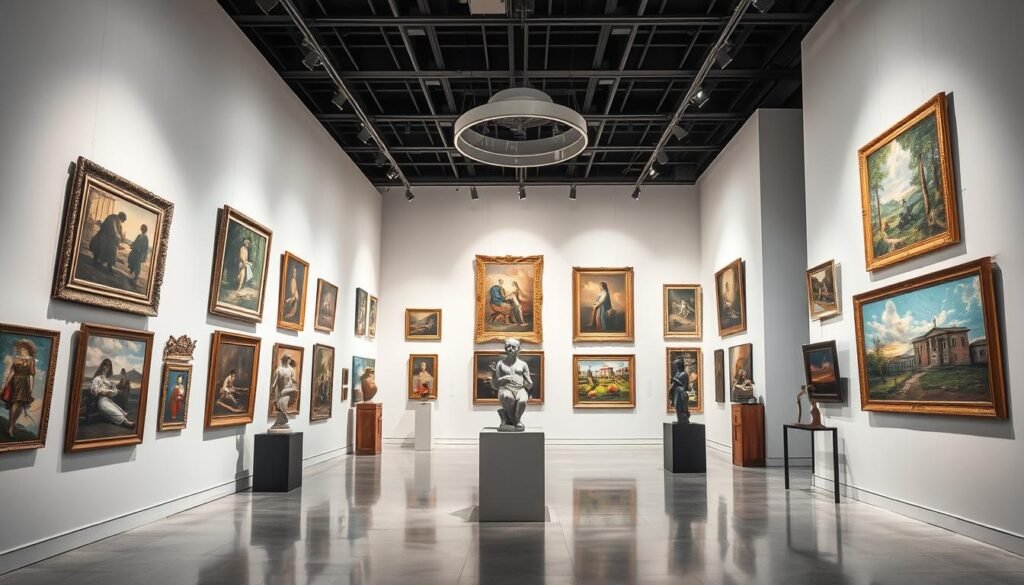As you enter your living room, your eyes go straight to the empty wall above the sofa. It’s waiting for the perfect artwork. But where should you place that beautiful painting or photo? The key is in the art of placement, balancing height, scale, and proportion to make the room special.
Jessica, a skilled interior designer, had a solution for her client’s blank wall. “Proper art placement is key,” she said. “It’s not just about hanging something. It’s about creating harmony and balance in the space.” Jessica showed her client the 7 essential rules to make their artwork stand out.
Table of Contents
- 1 Understanding the Importance of Proper Art Placement
- 1.1 The Impact of Art Height on Room Aesthetics
- 1.2 Common Mistakes in Artwork Positioning
- 1.3 Relatedarticles
- 1.4 8 Approaches to Choosing the Perfect Focal Point for Any Room
- 1.5 5 Common Scale Mistakes and How to Correct Them
- 1.6 8 Tips for Using Mirrors to Enhance Proportion and Focus
- 1.7 Why Scale Matters in Art Display
- 2 The 57-Inch Rule: Your Essential Guide to Art Height
- 3 Artwork Height and Scale Guidelines
- 4 Placing Art Above Furniture: Special Considerations
- 5 Creating Balance with Multiple Artworks
- 6 Scale and Proportion: Choosing the Right Size Artwork
- 7 Special Circumstances: High Ceilings and Architectural Features
- 8 Professional Tips for Perfect Art Installation
- 9 Conclusion
- 10 FAQ
- 10.1 What is the 57-inch rule for hanging artwork?
- 10.2 How does the scale of artwork impact a room’s aesthetics?
- 10.3 How should I hang artwork above furniture?
- 10.4 What are the guidelines for creating a gallery wall?
- 10.5 How do I choose the right size artwork for my room?
- 10.6 How do I adjust artwork placement for rooms with high ceilings?
- 10.7 What professional tips should I follow for proper art installation?
- 11 Source Links
Key Takeaways
- The best height for hanging artwork is 57-60 inches from the floor to the center.
- Scale and proportion are vital, with the artwork’s width ideally 2/3 the furniture’s size.
- High ceilings, gallery walls, and artwork above furniture need special care.
- Using the right hardware is important for a secure and level display.
- Following these rules can make a room look cohesive and beautiful.
Understanding the Importance of Proper Art Placement
Proper art placement is key to a harmonious room. The size and height of your artwork greatly affect the room’s look. It can turn a room into a welcoming space or make it feel off.
The Impact of Art Height on Room Aesthetics
It’s important to hang your artwork at the right visual center. Experts say to place the eyeline of the artwork at about 57 inches from the floor. This height makes viewing comfortable and blends the artwork well with the room layout.
Common Mistakes in Artwork Positioning
Hanging framed art too high can make a room feel off-balance. On the other hand, placing it too low can make the space feel tight. It’s also important to consider how the art frames relate to the furniture for a unified look.
Why Scale Matters in Art Display
The size of your artwork compared to the wall and other elements is vital. Choosing the right size visual center of artwork can make the room look bigger and more interesting. The right scale ensures your artwork doesn’t seem too small or too big.
Understanding the importance of art placement can change your space. It can make your interior stunning and show off your personal style and vision.
The 57-Inch Rule: Your Essential Guide to Art Height
Proper art placement is key to a harmonious and pleasing space. The 57-inch rule is a well-known guideline. It suggests hanging artwork so its center is 57 inches from the floor. This height aligns with the average eye level, making viewing comfortable and balanced.
To follow the 57-inch rule, measure 57 inches from the floor and mark the wall. Find the artwork’s center by dividing its height by two. Measure from the artwork’s top to the hanging wire, then subtract this from the center point. Add the result to the 57-inch mark to find the exact hanging spot.
This method is effective for most cases. But, you might need to adjust the height based on furniture or room features. For low ceilings or sitting areas, use the lower end of the 57-63 inch range. For high ceilings or tall people, the upper end is better.
Following the 57-inch rule balances and symmetrizes your space. It also places your artwork at the perfect eye level for art. This simple guideline enhances your space’s aesthetic and showcases your artwork beautifully.
| Guideline | Recommendation |
|---|---|
| Artwork Center Height | 57-60 inches from the floor |
| Artwork Above Furniture | 6-8 inches between top of furniture and bottom of frame |
| Artwork Above Fireplace | Around the same width as the fireplace opening or 2/3 the size of the fireplace surround |
| Gallery Wall Spacing | 3-6 inches between pieces, with smaller artwork at 3 inches and larger at 5-6 inches |
By using these guidelines and the 57-inch rule, your artwork will be hung art for symmetry and balance. This creates a stunning and harmonious living space.
Artwork Height and Scale Guidelines
Choosing the right artwork for your space is more than picking a piece. It’s about placing and scaling it correctly. Follow these tips for a balanced and harmonious art display.
Measuring for Perfect Placement
For rooms with 8-foot ceilings, start with the 57-inch rule. Place the artwork’s center about 57 inches from the floor. For higher ceilings, hang it a bit higher but keep the view level.
Adjusting for Different Room Heights
When hanging art above furniture, leave 4-8 inches of space. This makes the look balanced. For example, above a couch, leave 8-10 inches of space.
Scale Considerations for Various Wall Sizes
Your artwork’s size should match the wall. Aim for it to fill 1/2 to 2/3 of the wall space. For big walls, use large art or groupings. In small spaces, choose small-scale art to avoid clutter.
By following these art display guidelines for vertical and horizontal art placement, your artwork proportions will fit your space perfectly. Whether it’s large-scale art or small-scale art, it will enhance your living area.
Placing Art Above Furniture: Special Considerations
When hanging art above furniture, the 57-inch rule might not always work. Instead, focus on making the art and furniture look good together. Leave 4-8 inches between the top of the furniture and the art’s bottom for a nice balance.
The art’s width should be 2/3 to 3/4 the furniture’s width. This makes sure the art looks right with the room. For example, art above a fireplace should be 4-6 inches above the mantel for a balanced look.
Art above a bed should be centered and cover about 2/3 of the headboard’s width. This keeps the art connected to the bed, making the room look better.
By following these tips for art above furniture, art above a sofa, art above a bed, and art above a fireplace, you can make your space look great. Remember, the space between art and furniture is important for a good design.
“Proper placement and scale are key to making artwork feel like an intentional and integrated part of a room’s design.”
Creating Balance with Multiple Artworks
Designing a gallery wall or grouping artworks requires treating them as one piece. It’s important to balance the different elements. This ensures they blend together to create a stunning display.
Gallery Wall Spacing Tips
Spacing between artworks is key for a good gallery wall. Keep a 2-3 inch gap between each piece for a cohesive look. This spacing helps the eye move smoothly from one piece to the next, making the display feel intentional and unified.
Grouping Different Sized Pieces
Start with the largest piece as the anchor of your grouping. Then, add smaller pieces around it to balance the display. Mix the orientation and medium of the artworks to avoid a dull look.
Visual Weight Distribution
Pay attention to the visual weight of your gallery wall. Mix large and small pieces, light and dark elements for balance. Symmetrical displays bring order, while asymmetrical ones add energy.
Think of your gallery wall as a single art piece. Consider spacing, size, and balance to turn a blank wall into a stunning showcase. It will reflect your unique style and taste.
Scale and Proportion: Choosing the Right Size Artwork
Finding the perfect artwork size is key for a balanced room. It’s about matching the art with the room’s size, whether it’s big or small. Here are some tips to pick the right art size for your space.
For big walls, go for large pieces or groupings that cover two-thirds of the wall. This makes a bold statement. But, in small rooms, avoid big art. Instead, pick smaller pieces or a gallery wall for a better fit.
Think about the room’s purpose when picking art size. Big pieces are great for living areas to draw attention. Bedrooms, though, might do better with softer scales for a calm vibe. The frame size matters too. Big frames can make small art stand out, while simple frames let big pieces shine.
| Room Size | Ideal Art Size | Frame Consideration |
|---|---|---|
| Large Walls | Oversized or Grouped Pieces (≥2/3 Wall Width) | Large Frames for Impact |
| Small Rooms | Smaller Pieces or Gallery Wall | Simple Frames to Avoid Overcrowding |
| Living Areas | Statement Pieces | Frames to Complement Artwork |
| Bedrooms | Subdued Scales | Frames to Create a Calming Atmosphere |
By thinking about the room’s size, purpose, and art size, you can create a beautiful display. Art is a way to show your style, so don’t be afraid to be different.
“The right artwork can transform a space, but choosing the wrong size can throw off the entire aesthetic. Pay attention to scale and proportion to ensure your art makes the desired impact.”
To get the art placement right, use painter’s tape or paper cutouts as a mock-up. This lets you see how the art fits before you hang it for real.
Special Circumstances: High Ceilings and Architectural Features
High ceilings and unique architectural elements can be both a challenge and an opportunity for art placement. Thinking carefully about these aspects can help you achieve balance and harmony in your space.
Working with Unique Room Features
In rooms with high ceilings, the usual 57-inch rule for artwork height might not work. For ceilings over 8 feet, add 3 inches to the center height for every foot over 8. This keeps the artwork in proportion and visually balanced.
When dealing with architectural features like chair rails, wainscoting, or built-in shelving, align your artwork with them. This creates a cohesive and intentional look by making the artwork interact with the room’s design.
Adjusting for Different Ceiling Heights
For rooms with lower ceilings, using horizontal artworks can make the space seem larger. Also, aligning the artwork with the angle of sloped ceilings helps maintain balance.
Regardless of the ceiling height, always think about the room’s overall balance. How the artwork interacts with other design elements is key. By making strategic adjustments, you can make your art placement enhance your space’s unique character.
“When in doubt about sizing, opting for an oversized piece of artwork is recommended for a more aesthetically pleasing look.”
Professional Tips for Perfect Art Installation
To make your home look great with art, you need more than just the basics. You need the right tools, a well-prepared wall, and to level everything perfectly. These expert tips will help you create a display that looks like it belongs in a gallery.
Choosing the Proper Hanging Hardware
Start by picking the right hardware for your art and wall type. Light pieces might use adhesive or picture hangers. But, heavy art needs strong anchors or wall studs. Floreat™ Hangers offer weights from 10 to 75 lbs for a secure hold.
Leveling and Aligning Your Artwork
Getting your art perfectly level and aligned is key. Always use a level to make sure it’s straight and centered at 57 inches from the floor. For art over 120 lbs or on unique surfaces, use heavy-duty anchors for a secure and level mount.
Planning Your Gallery Wall Layout
When hanging multiple pieces, use kraft paper to plan your layout first. This lets you try out different arrangements and spacing. Aim for a look with no more than 2 inches between pieces for a striking gallery wall.
Preparing the Wall for a Professional Finish
Good wall prep is essential for a flawless installation. Fill and paint over any old nail holes for a smooth surface. For valuable art, consider a professional installer for safe and secure mounting.
By following these professional tips, you can make your home’s art display look amazing. Remember, the right tools and attention to detail are key to a gallery-worthy display that will impress.
| Hanging Tool | Recommended Product | Weight Capacity | Price |
|---|---|---|---|
| Floreat™ Picture Hangers | Floreat™ Picture Hangers | 10 lb, 20 lb, 30 lb, 50 lb, 75 lb | Varies |
| Picture Hanging Wire | United Manufacturer’s Supplies Tuflon Coated Wire | No weight limit | $20 |
| Wall Repair Filler | United Mfrs Supply Nail Hole and Corner Filler | N/A | Varies |
“Properly hanging art at eye level is key; aim for around 57 inches from the floor, accommodating different heights.”
Conclusion
Putting art in the right place is key to making your space look good. Start with the 57-inch rule and adjust for your room’s needs. Think about the size and how it fits with other things in the room.
Whether it’s one big piece or a bunch of smaller ones, these artwork height and scale guidelines will help. With a bit of practice, you can make your home look amazing. This way, your art will stand out in the best way.
Using these tips, you can make any room feel better. They help you use your art to make your home look even better. These ideas are a great start to making your home beautiful.
FAQ
What is the 57-inch rule for hanging artwork?
How does the scale of artwork impact a room’s aesthetics?
How should I hang artwork above furniture?
What are the guidelines for creating a gallery wall?
How do I choose the right size artwork for my room?
How do I adjust artwork placement for rooms with high ceilings?
What professional tips should I follow for proper art installation?
Source Links
- 7 Tips for Hanging Wall Art
- Foolproof Ways To Choose The Right Heights To Hang Artwork
- How to Hang Art Correctly – Emily Henderson
- 3 Simple Rules for Hanging Art
- How to hang pictures – tips and guidelines — Michelle Binette Design
- How High to Hang Pictures and Artwork (with Printable Guide)
- You’re Hanging Art Wrong. Here’s How to Fix It.
- Rules of Thumb To Help You Hang Art Correctly Every Time
- Learn How To Choose The Right Size Art
- Wall Art Size Guide | Nations Photo Lab
- JRL Interiors — Do’s and Don’ts for Hanging Artwork
- How High to Hang Pictures
- How to Arrange Wall Art: The Complete Art Placement Guide
- DESIGN MISTAKE: Different Walls, Same Art Configurations (AKA It’s Time To Bring Life To Your Walls) – Emily Henderson
- Composition in Art: The Secret Sauce to Captivating Artwork
- How to Choose Art That Is The Right Size For Your Space – JONES DESIGN CO.
- How To Size Art For A Wall
- How High To Hang Pictures (Guide For The Perfect Height)
- Design ideas for rooms with high ceilings by Margaret Chambers
- How High Should Artwork & Mirrors Hang?
- Elevate with Art: the do’s and dont’s of hanging art and how to find the right style to suit your space
- How to Hang a Painting | A Free Guide From Xanadu Gallery – RedDotBlog
- How to correctly hang artwork, according to an interior designer
- How to analyze an artwork: a step-by-step guide
- Rules for Proportion | THISisCarpentry
- Finding the Perfect Height: A Guide to Picture Hanging for Maximum Impact — For Arts Sake




